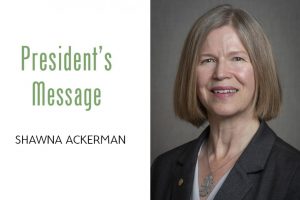By Ken Kent
I hope that someday when I mention I am an actuary, the response will be one of recognition of the essential part we play in supporting financial security for everyone. Lately when introducing myself, I’ve been identifying that the actuarial profession’s work product is the foundation for helping people secure financial needs when it is most needed.
Saying these words is one thing. Defining what the Academy and its volunteers are doing every day to secure the public’s trust is perhaps not well understood by the public—and in some cases, members of the profession who are not involved in volunteering activities for any of the five actuarial organizations in the United States.
I realized that we sometimes struggle when it comes to drawing the direct connection between what our volunteers do and how it relates to safeguarding the needs of the public while maintaining their trust—and why being a member of the Academy to support its mission is so important for all actuaries. So, I thought I might ask the different practice areas, “What work product has the Academy recently completed that relates to serving the profession and the public?”
I posed the question to Lisa Slotznick, the Academy’s president-elect and a property-casualty actuary. The following is a recollection of our discussion.
Lisa: Well, in December, the Casualty Practice Council completed the annual Statements of Actuarial Opinion on P/C Loss Reserves practice note—a month earlier than in the past.
Ken: That’s great … but why is it important?
Lisa: Actuaries wait for the Academy’s practice note before issuing annual statements of opinion to state regulators regarding the financial state of domiciled insurance companies—and by getting access to it a month earlier, they have more time for their submission.
Ken: OK, but what does that mean for the public?
Lisa: Each year, the actuary submits to regulators the financial status of the insurance companies so the regulators can gauge the ability of these companies to pay the claims the public is paying for. In this way we—the actuaries—are measuring and disclosing the financial safety of the protections people are insuring.
This was just one example of the type of work performed by the Academy on behalf of the public. But we could perhaps be better at explicitly communicating the connection between our work and the value our work has for the public.
So let me take the remainder of my space to do just that.
Just a few of the projects that have been completed this year that demonstrate the value for the public in helping to meet their financial needs include:
- The Life Practice Council addressed the growing
needs to support principle-based reserving for annuities (VM-22).
- The Life Practice Council submitted an 80-page draft to the National Association of Insurance Commissioners on regulations for determining reserves for fixed annuities.
- This Academy proposal was developed to meet state regulators’ request to modernize the framework for how much money life insurance companies hold for future annuity benefits that fund policyholders’ retirement income.
- This Academy work enhances financial security by creating a reserving methodology that more accurately covers obligations for future policyholder income even in adverse future economic scenarios, ensuring that an insurance company has money on hand to make sure the public can live their senior years safely and securely.
- The Health Practice Council has published its
annual report, Medicare’s Financial Condition: Beyond Actuarial Balance,
which is an actuary’s-eye-view source of information on the financial status of
the Medicare program.
- The Academy recognizes the important contribution that members of the actuarial profession have made in preparing the Medicare Trustees Report, the annual document on which the Academy’s report is based.
- Academy members play a vital role in providing information to the public about the important issues surrounding the program’s solvency and sustainability.
- The Beyond Actuarial Balance report is designed to provide information for the public with conclusions on steps that are necessary and appropriate for policymakers’ consideration.
- The Pension Practice Council recently updated
and rebranded the Social Security Challenge.
- This interactive program allows anyone to explore the implications of different changes to the program to see what the implications are for long-term sustainability of this vital program.
- The Challenge is an update to the previous “Social Security Game” and has captured the attention of policymakers by providing a deep understanding for laypeople of the implications of potential solutions to the financial challenges facing Social Security.
- This Challenge is accessible to educate the American people about Social Security and the hurdles the program faces, engaging them to take ownership of learning about the government program and giving them an opportunity to participate in what it could be like to solve Social Security.
Our 1,200 Academy volunteers are dedicating their time providing so much for the public. It is important to understand and appreciate how this work is dedicated to supporting the financial security for everyone in the United States. My objective with this message is to provide some actual examples, so when someone says, “Oh, you are the people who can tell me how long I am going to live,” you can come back with, “That—and so much more.”





